In the heart of the Amazon rainforest, Shipibo healing traditions have flourished for centuries. These ancient practices, centered around the use of Amazonian medicinal plants, offer profound insights into spiritual and physical healing. At the core of these practices are the plants that the Shipibo people have revered as both physical remedies and spiritual teachers. From Ayahuasca (Banisteriopsis caapi), a sacred plant used in vision-inducing ceremonies, to Bobinsana (Calliandra angustifolia), known for its heart-opening properties, these plants hold the keys to healing, growth, and transformation.
Night falls in a remote village along the Ucayali River. Inside a thatched maloca (ceremonial hut), a Shipibo curandero(traditional healer) softly sings an icaro (medicine song) as fragrant mapacho tobacco smoke curls through the air. In front of him sits a pot of ayahuasca brew and an assortment of medicinal leaves, roots, and barks from the jungle. To the Shipibo people – who have spent generations mastering the Amazon’s pharmacy – each plant is more than a remedy; it is a teacher and spiritual ally. Through holistic healing practices like master plant dietas, Shipibo healers unlock the plants’ physical and spiritual virtues to cure illness and guide deep transformation.
Travelers from across the world now come to ayahuasca retreats in Peru to benefit from this ancient wisdom. In these retreats, they sit in ceremony with Shipibo curanderos, follow strict master plant dietas, and discover healing as a journey of body, mind, and spirit. This article explores the most important Amazonian plants used by Shipibo healers – from visionary Ayahuasca to cleansing Ajo Sacha – and how curanderos use these plants in dietas and healing ceremonies. We’ll also see how these traditions are being integrated into ayahuasca retreats for international seekers in search of deep healing.
The Shipibo-Konibo are an indigenous people of the Peruvian Amazon with an unbroken lineage of plant healers. A curandero in this tradition works with a living pharmacy of jungle plants, known in the Shipibo language as rao(medicine). What makes Shipibo healing unique is the belief that every medicinal plant has an animating spirit or essence. Curanderos train for years to communicate with these plant spirits and harness their energies for healing. During ayahuasca ceremonies and special dietas, the healer “attunes” to the plant spirits, acting as a conduit for their wisdom and power. As one source describes, Shipibo curanderos align themselves with the “high-frequency energies” of plants, recognizing that each plant carries a unique vibrational essence that can influence the body, mind, and spirit.
Central to Shipibo healing is the use of icaros, or medicine songs. These songs aren’t invented by the healers but learned directly from the plants during periods of strict training and fasting. In ceremony, a curandero may sing an icaro to call upon a particular plant’s spirit to help a patient. The song is essentially the vibration of the plant translated into melody, directing the plant’s healing energy where it’s needed. In traditional practice, patients might not even drink ayahuasca; only the curandero drinks, entering the spirit world to consult the plant spirits on the patient’s behalf. However, as interest in Amazonian healing has spread globally, it’s now common for both healer and patient to drink the brew together. The philosophy remains the same: illness is seen as an imbalance or blockage often rooted in spiritual causes, and plant spirits are called in to remove these blockages and restore harmony. The curandero mediates between visible and invisible realms, using ritual, song, and plant remedies so that the “life force” of the plants can ignite the patient’s innate healing process.
In Shipibo curanderismo, the master plant dieta is an indispensable practice for deep healing and for apprentices to learn directly from plant teachers. While ayahuasca ceremonies are the “trunk” of the healing tradition, plant dietas are the “roots” that sustain and deepen it. A master plant dieta is essentially a covenant between a healer (or patient) and a specific plant spirit. The person commits to ingest a preparation of the plant and abstain from various pleasures and social interactions in exchange for the plant’s teachings and healing.
A typical dieta involves retreating into isolation, often a simple jungle hut, for a period ranging from days to months. Under a curandero’s guidance, the dieter consumes the “teacher plant” daily or periodically (whether as a tea, tincture, or other form). They also eat a very plain diet (e.g. bland plantains or rice, with no salt, sugar, oil, or spices) and avoid sexual activity, alcohol, and other stimulants. By eliminating distractions and toxins, the participant becomes more sensitive to the plant’s subtle communications. In essence, the dieta is an act of sacrifice and focus: a demonstration to the plant spirit of one’s commitment to learn and heal.
Many dieters report vivid dreams or visions in which the plant spirit teaches them. A curandero typically opens the dietawith an ayahuasca ceremony, singing special icaros to invite the plant’s spirit into communion. Throughout the dieta, the apprentice or patient may face physical and emotional challenges (for example, dieting Chiric Sanango often brings intense chills and purging), which are seen as the plant working to cleanse and reconfigure them. If the dieter adheres to the process, by the end they often receive some form of gift, an apprentice may gain a new icaro (medicine song) from the plant, or a patient may feel a deep trauma has been released. The plant becomes both doctor and teacher in their healing journey.
No plant is more central to Amazonian healing than Ayahuasca, often called the “mother of all plants.” Ayahuasca is both the name of a woody vine (Banisteriopsis caapi) and the powerful brew made from that vine (usually mixed with chacruna leaves rich in DMT). In Shipibo, it’s known as oni or nishi. This sacred brew is the cornerstone of Shipibo ceremonies, a master plant that opens the door to the spiritual world.
During a nighttime ceremony, participants drink the bitter, dark tea of ayahuasca. Under the guidance of the curandero’s icaros, the brew induces vivid visions and intense physical and emotional purging. The visions, often involving serpents, jaguars, spirits of the forest, and ancestral beings, are regarded as spiritual revelations, not hallucinations. They allow the healer and patient to see the energetic roots of illness and receive guidance from plant spirits. Many people encounter the spirit of Ayahuasca herself, commonly perceived as a wise grandmother or a giant serpent who can perform psychic “surgery,” extract negative energies, and impart teachings about living in harmony.
Beyond its spiritual effects, ayahuasca has notable medicinal properties. The Peruvian Amazon medicinal plant compendium notes that ayahuasca (the B. caapi vine) is used as a memory stimulant and even as a folk treatment for Parkinson’s disease. Ayahuasca is also regarded as a purgative indeed, one traditional use is as an emetic and laxative to cleanse the body of parasites and toxins. This purging is central to its healing action: the nausea, sweating, and vomiting it triggers are thought to expel not just physical impurities but negative energies or emotions as well. (It’s no coincidence ayahuasca is often called la purga: “the purge.”)
Chiric Sanango (Brunfelsia grandiflora), sometimes simply called sanango, is one of the most intense teacher plants in the Amazon. The Quechua word “chiric” means “cold” – a nod to the pronounced chill one feels after ingesting it. Drinking a Chiric Sanango infusion can make even a person in the hot jungle shiver to the bone. Shipibo healers interpret this as the plant driving out the “cold” of illness and fear, ultimately replacing it with strength and warmth.
Physically, Chiric Sanango is valued as a tonic for the nerves and bones. Healers use a tincture of its root or bark (macerated in cane alcohol) to treat arthritis, rheumatism, and general weakness. It’s also taken as a reconstituent (restorative) after long illnesses, to rebuild a person’s strength. Other recorded uses include reducing high fevers and tackling stubborn infections like leishmaniasis (uta) and even syphilis. In these remedies, the bark or root is boiled or soaked to extract its potent alkaloids. Essentially, Chiric Sanango is a cure for conditions of frío interno (internal “cold”), joint pains, chills, fatigue and warming the body from within.
Spiritually, Chiric Sanango is known for instilling courage and resilience. Dieting this plant is a formidable ordeal; those who complete it are said to emerge braver and more grounded. It “is used to overcome fear, restore courage, and clear emotional blockages,” notes one ethnobotanical guide. After enduring Chiric Sanango’s trials (the bone-deep chills, isolation, and purges), many report that fears which once paralyzed them no longer hold power. Some curanderos also add a small dose of Chiric Sanango to ayahuasca brews, believing it adds psychic strength or acuity to the experience. In fact, the roots of Chiric Sanango are regarded as a “fortalecedor psíquico” – a psychic fortifier – for hunters and shamans who need extra focus and courage.
A staple in the Shipibo healer’s toolkit is Ajo Sacha (Mansoa alliacea), which means “wild garlic.” This vine isn’t true garlic, but its leaves release a strong garlic-like aroma when crushed, thanks to sulfur compounds similar to those in garlic. That pungent scent hints at its power as a cleansing and protective plant. Shipibo curanderos often use Ajo Sacha to spiritually “smudge” or cleanse patients, believing the plant’s essence can drive away negative energies much like its smell repels insects and bats.
Medicinally, Ajo Sacha is a natural analgesic and anti-inflammatory. It’s a go-to remedy for pain – from headaches to joint aches. People drink an infusion of the leaves to relieve internal pain, and also apply the crushed leaves externally on the temples or on swollen joints for localized relief. For fevers, a decoction of the stems and leaves is taken internally (and sometimes used as a bath) to help “sweat out” the illness. For rheumatism, the vine or roots are macerated in alcohol to create a liniment that is rubbed into sore limbs and backs. Through these uses, Ajo Sacha has earned a reputation for treating everything from stubborn colds to arthritic pains.
The spiritual application of Ajo Sacha is equally valued. Healers often administer Ajo Sacha at the very start of a healing regimen or retreat dieta to cleanse the aura and ward off any lurking negative influences. Drinking a strong Ajo Sacha tea at dawn for a few days serves as an energetic purgative, essentially fumigating the patient’s spirit. One ethnographic source notes that people burn Ajo Sacha leaves in homes to drive away bats and insects, symbolically mirroring how the plant drives out malevolent forces from a person’s body or surroundings. Because of this, Ajo Sacha is seen as a potent protector that “protects against negative energies and wards off illness”. It is often included in herbal baths for spiritual cleansing; after being doused in Ajo Sacha and other aromatic herbs, patients frequently report feeling lighter and more positive.
Thanks to these properties, Ajo Sacha is commonly the first plant introduced in a master plant dieta for newcomers. It “opens the way” by purifying the body and soul, making the individual more receptive to other plant teachings. Foreign participants who take Ajo Sacha during retreats often note how it lifts their mood and eases anxiety, as if a dark cloud were dispelled.
Looming tall in the rainforest is Chuchuhuasi (Maytenus macrocarpa), a mighty Amazonian tree whose name can be translated as “trembling back.” Its thick, reddish bark is packed with medicinal power. Traditionally, pieces of Chuchuhuasi bark are soaked in aguardiente (sugarcane liquor) to create a famous jungle tonic. A shot of this bitter tonic each morning is said to invigorate the body, ease aches, and even boost libido.
Chuchuhuasi is most renowned as a remedy for pain and fatigue. Healers prescribe its bark for arthritis, back pain, and rheumatism – any ailment involving joints, bones, or muscles. A decoction or tincture of the bark can effectively relieve pain and reduce inflammation, helping those with stiff backs or swollen joints regain mobility. It’s popular among the elderly and manual laborers as a daily elixir to “put strength back in the spine.” Chuchuhuasi also aids digestion and respiration. It’s used to treat chronic diarrhea, soothe persistent coughs, and fortify a weak immune system.
Another famed use of Chuchuhuasi is as an aphrodisiac and energy booster. The bark, when macerated in alcohol for weeks, yields an amber-colored liquor long used to enhance libido and stamina. This property of “putting fire in the body” is why curanderos may give a small Chuchuhuasi infusion to someone who is chronically fatigued or recovering from illness, to accelerate their recovery. In Shipibo, Chuchuhuasi “warms the body” and revitalizes the spirit – effectively recharging one’s battery. It’s considered an energizing tonic that helps the body fend off weakness and exhaustion.
Chuchuhuasi is not hallucinogenic but its benefits are primarily physical. Still, Shipibo curanderos regard its spirit as a strong, steady presence, and some healers diet on Chuchuhuasi to fortify their bodies for the rigors of ceremony.
In sum, Chuchuhuasi is a cornerstone of Amazonian herbalism for restoring strength and vitality. Many foreign visitors who try it during retreats find that it simply makes them feel good – easing the soreness from jungle living or post-ceremony purging, and helping them sleep deeply. It’s not a dramatic teacher like Ayahuasca, but rather a nurturing healer that rebuilds the foundation of health, which is often just as crucial for a successful transformative journey.
Uña de Gato, or Cat’s Claw, is a woody vine (commonly Uncaria tomentosa, among related species) named for its claw-shaped thorns. In Amazonian medicine it’s famous as a powerful immune booster and anti-inflammatory. Shipibo healers use Cat’s Claw primarily for chronic internal disorders. It’s like the rainforest’s version of an immune system tonic.
Preparations of Uña de Gato typically involve boiling the bark into a tea. It’s given for arthritis and rheumatism to reduce pain and swelling, for urinary infections as a diuretic and blood cleanser, and even as a supportive remedy for cancer and other immune-related illnesses to stimulate the body’s defenses. People with chronic inflammatory conditions (like arthritis or gastritis) often take Cat’s Claw in week-long courses to calm the body’s overactive responses. Indeed, Peruvian ethnobotanies list Uña de Gato among treatments for cancer and liver cirrhosis, reflecting its use in serious degenerative diseases.
By the 1990s, Peru was exporting hundreds of tons of Uña de Gato bark annually to meet global demand. Today it remains one of the best-known Amazonian medicinal plants worldwide, often found in health food stores as capsules or tinctures.
For Shipibo healers, Uña de Gato is not a visionary plant but is included in dietas for chronic illness. Its spirit is considered mild but persistent, working by removing “poisons” from the body (in line with its detoxifying role). On retreats, Cat’s Claw tea often plays a supportive role between ceremonies, helping reduce inflammation and rebuild strength. It’s a steady ally that may not provide visions, but it restores balance and health in a deeply effective way.
Over the past twenty years, many ayahuasca retreat centers have sprung up in the Peruvian Amazon, making Shipibo healing accessible to global seekers. A typical retreat spans one to two weeks and features several ayahuasca ceremonies led by Shipibo healers at night in a maloca, with translators and facilitators assisting the foreign participants. Visitors are expected to follow basic dietary restrictions (avoiding pork, alcohol, etc.) that mirror the tradition’s preparatory diet.
These retreats strive to honor and integrate the master plant dieta tradition as well. Many enforce similar disciplines (bland food, sexual abstinence during the program), and some even offer a short “dieta” experience. For example, drinking a gentle plant extract and spending quiet time in nature under the curandero’s guidance.
Shipibo healers see sharing their plant medicine with outsiders as part of their purpose. As one maestro noted, spreading this wisdom helps “bring humanity back into balance”. Many retreat guests arrive with hard-to-treat ailments like depression, PTSD, or addiction. Through the combination of ayahuasca ceremonies and supportive plant remedies, they often experience breakthroughs that eluded them in conventional therapy. The Shipibo approach addresses healing on all levels – reaching the “psychological, emotional, spiritual, and energetic taproots of trauma”.
The results have been striking: thousands of international guests have reported life-altering transformations from these retreats. In this meeting of worlds, a two-way exchange occurs: individuals find holistic healing, and the wider world rekindles respect for the ancient knowledge carried by the Amazon’s medicinal plants.
The Peruvian Amazon is home to a vast diversity of medicinal plants that have been used for centuries by the Shipibo-Conibo people. Each plant is considered to carry its own spirit, intelligence, and teaching. Working with these plants is not merely about physical healing, but about deep spiritual and emotional transformation. The dieta, a period of retreat and isolation with restricted food and contact, is the traditional way to learn from these plant spirits.
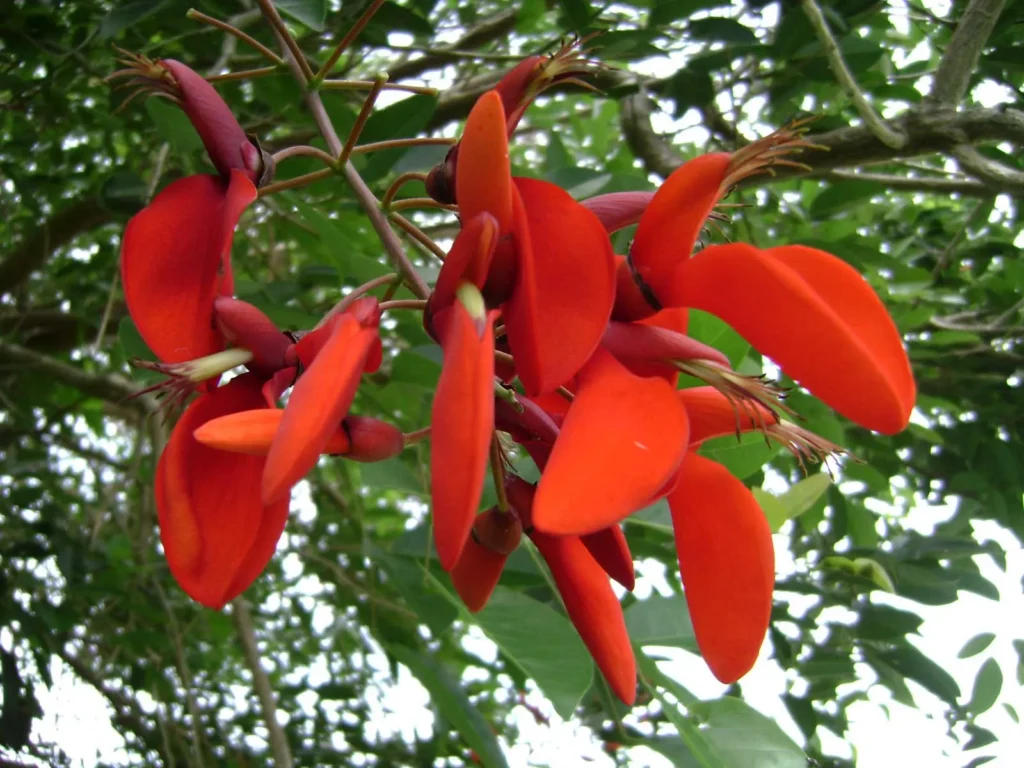
A tree whose bark and flowers are used for their calming and mild sedative properties. Traditionally valued in the Amazon for relaxation and reducing tension.
– Infusion of bark for calming anxiety and stress.
– Used as a mild sedative and muscle relaxant.
– Supports sleep and relaxation.
– Invites peace and tranquility in dieta.
– Used to calm agitation and bring balance to visions.
Considered a supportive plant for calming the mind before ceremony.
Huambisa, Bobinsana
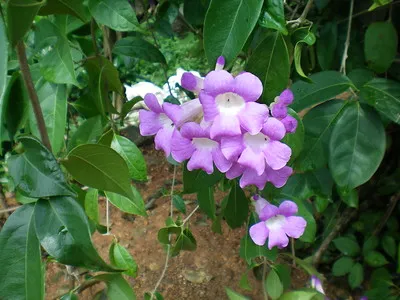
A woody vine with garlic-like smell, often used as a substitute for garlic. Known as a powerful cleanser in Amazonian medicine.
Dieted for purification and protection.
Bobinsana, Chiric Sanango
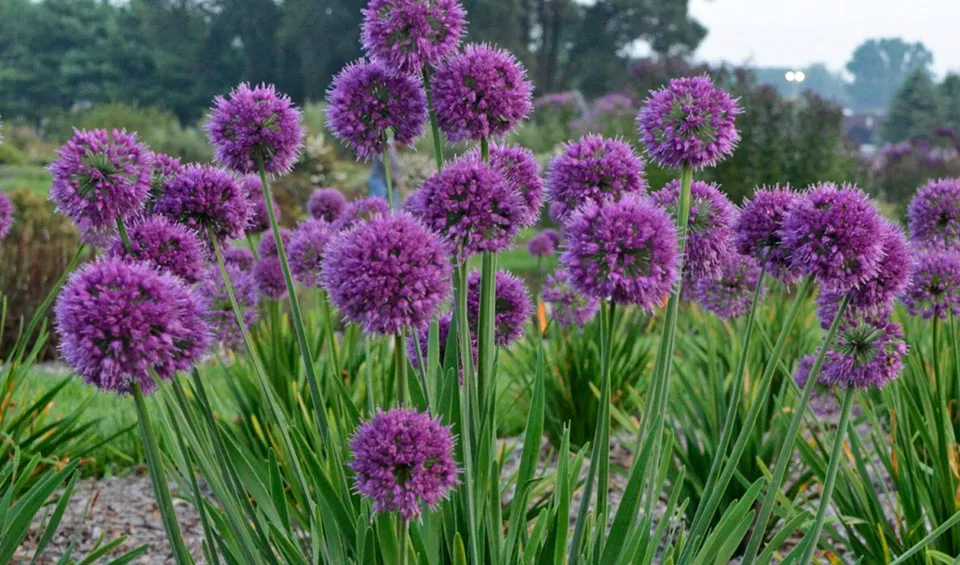
Closely related to ajo sacha, ajosillo carries a garlic-like aroma and is widely used for protection against illness and negative energies.
– Infusion for colds, fevers, and respiratory conditions.
– Used as an anti-inflammatory remedy.
– Cleanses heavy energies.
– Used in baths for protection against envy and bad luck.
Dieted as a protective ally similar to ajo sacha, though milder.
Ajo Sacha, Bobinsana

Sacred vine of the Amazon, central to shamanic ceremonies. Often combined with chacruna or other plants to induce visions.
Considered the mother of all plants and the main teacher spirit.
Chacruna, Bobinsana
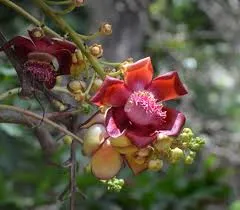
A potent plant used to access higher realms of consciousness. Known for its ability to facilitate profound, transformative journeys.
– Used for cleansing both physically and spiritually.
– Can induce intense purging effects.
– A teacher plant used to open doors to the spirit world.
– Facilitates deep transformation and receiving spiritual guidance.
Dieted for deep spiritual journeys, aiding in connecting with higher wisdom.
Ayahuasca, Chullachaqui Caspi
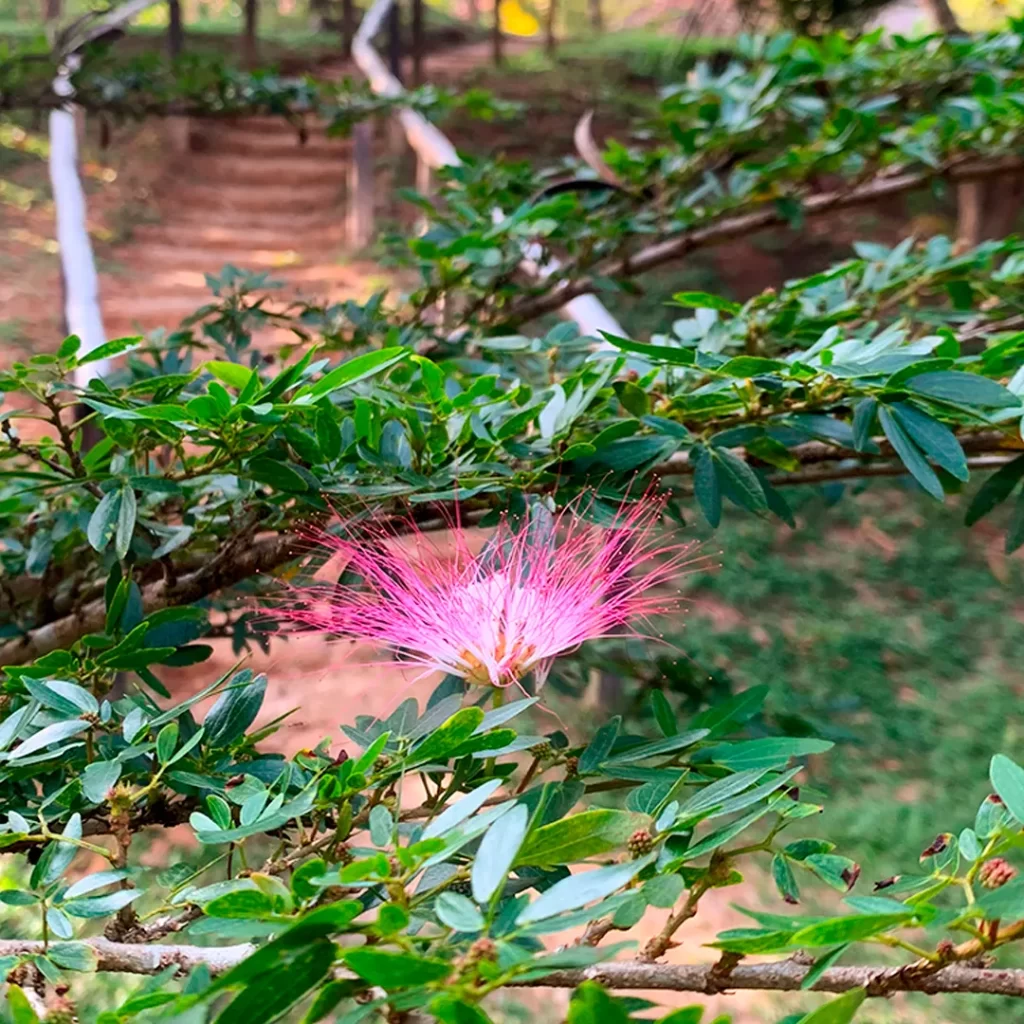
A small tree with pink flowers, cherished for opening the heart and softening emotional wounds.
Dieted for emotional healing, forgiveness, and compassion.
Ajo Sacha
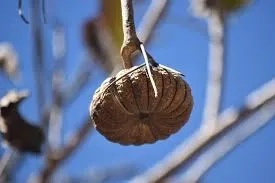
Known for its purgative properties, Catahua is used to cleanse both the physical and energetic body.
– Latex used for cleansing the body of toxins.
– Decoction for internal purification.
– Dieted for deep cleansing of negative energy.
– Teaches discipline and humility during purification.
Used in rigorous dietas to promote spiritual purification.
Ojé, Piñón Colorado
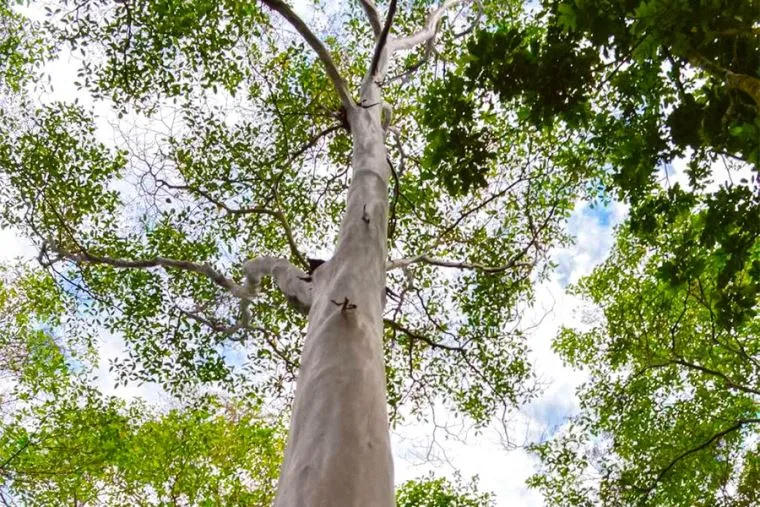
Capirona is a large tree native to the Amazon rainforest, valued for its protective and grounding properties. It is known for its bark, which is used in traditional healing practices for its purifying effects.
– Decoction of bark used for inflammation, fever, and to aid digestion.
– Traditionally used for its antibacterial and antifungal properties.
– Infusion for skin rashes and wounds.
– Helps bring clarity and protection during dieta.
– Associated with the forest’s guardian spirit, helping to ground and stabilize energies.
Dieted for resilience, grounding, and protection, Capirona helps in reconnecting with nature and the spirit of the land.
Lupuna, Huacapurana
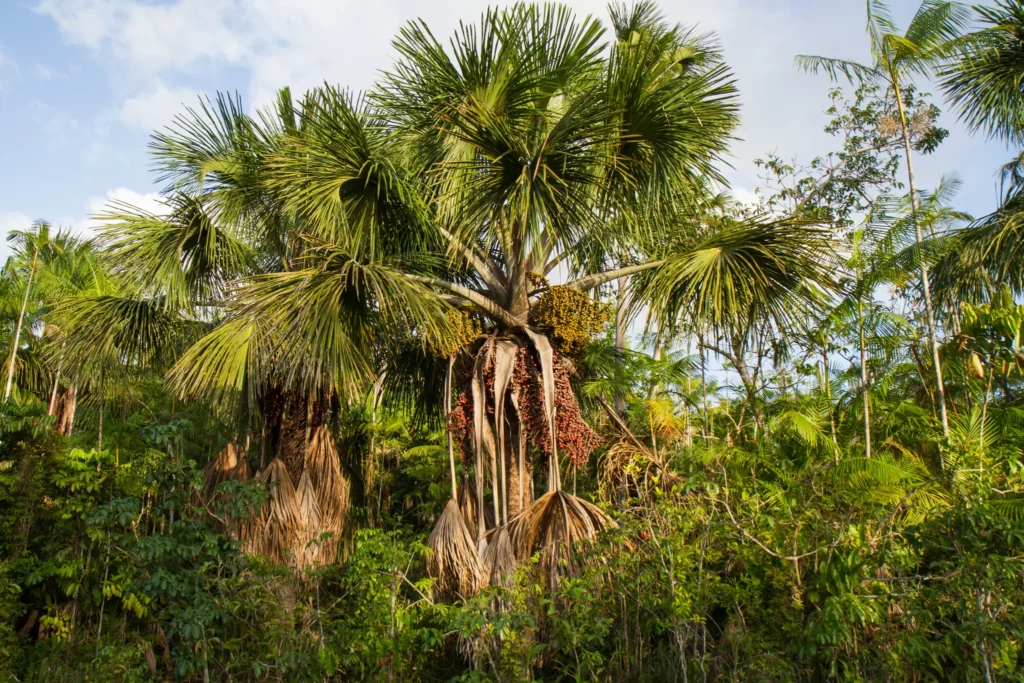
Capinuri, also known as aguaje or moriche palm, is an iconic plant in the Amazon. Its fruit is widely used for its nutritional and healing properties, while the palm itself offers a variety of medicinal and spiritual benefits.
– The fruit is used to treat digestive issues and boost vitamin intake.
– Oil from the fruit is used for moisturizing skin and treating burns.
– Leaves used for detoxification baths and treating respiratory ailments.
– Symbol of vitality and rejuvenation, consumed to promote health and strength.
– Leaves used in offerings and ceremonial cleansing.
Dieted to promote health, vitality, and rejuvenation. It is seen as a nurturing and protective plant.
Sacha Mango, Guarana
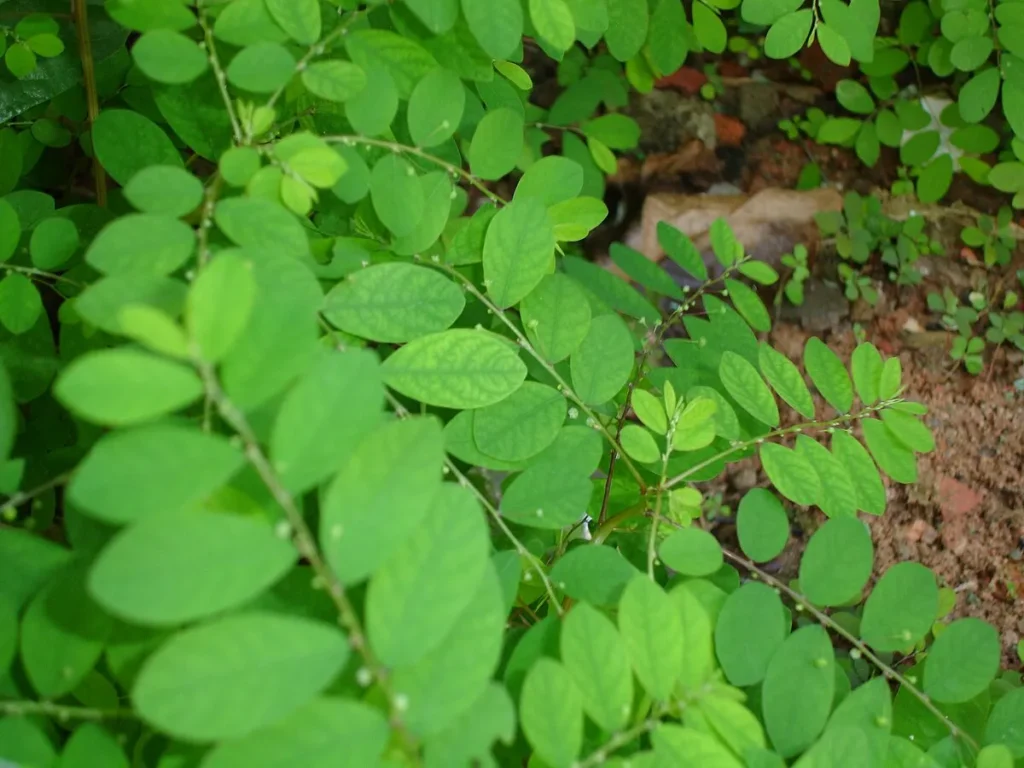
Known as ‘stone breaker’, Chancapiedra is used to dissolve kidney stones and support liver health.
– Infusion used to treat kidney stones and gallstones.
– Supports liver health and detoxification.
– Considered a cleansing plant that clears blockages in the body.
– Helps release fear and resistance, bringing flow and ease.
Dieted to purify the urinary and digestive systems, promoting the release of stagnation.
Flor de Arena, Bobinsana
Chacruna is one of the primary admixture plants used with Ayahuasca. Its leaves contain dimethyltryptamine (DMT), the molecule responsible for producing visions when combined with the MAO-inhibiting properties of the ayahuasca vine.
– Traditionally not used medicinally on its own but as part of the ayahuasca brew.
– Some traditions prepare it as a tea for mild stimulant properties.
– Central in ayahuasca ceremonies, providing the visions and teachings from the spirit world.
– Considered the ‘eyes’ of the brew, allowing participants to see beyond the physical realm.
Dieted alongside the ayahuasca vine, Chacruna helps open perception and teaches about the interconnectedness of all beings.
Chaliponga (Diplopterys cabrerana)
Huambisa, also called ’tilo’ in some regions, is a fragrant Amazonian plant with calming properties. It is often added to ayahuasca to soften the effects and bring clarity.
– Used as an infusion for colds, coughs, and respiratory discomfort.
– Applied for muscle relaxation and mild analgesia.
– Helps calm turbulent visions during ceremony.
– Invites peace, clarity, and heart-centered visions.
Known as a ‘teacher of peace,’ it helps bring harmony to the dieta process.
Guayusa
A tall tree known for its strong purgative latex. Used carefully in Amazonian traditions for deep physical and energetic cleansing.
– Latex used as a strong purgative.
– Applied externally for skin problems in diluted form.
– Dieted for discipline and purification.
– Clears blockages and heavy energies from the body.
Respected for its strength; used with caution in dieta as it can be overwhelming.
Piñón Colorado, Ojé
A strong and demanding master plant, known for its fiery energy that clears blockages.
Dieted as one of the most challenging and transformative plants.
Chullachaqui Caspi
Tall forest tree associated with the spirit of Chullachaqui, protector of the jungle.
Dieted to gain strength, courage, and alliance with jungle spirits.
Chiric Sanango
Copaiba is a resinous tree used as a natural antibiotic and anti-inflammatory, often compared to frankincense or myrrh.
Used as a supportive plant for physical and energetic healing.
Sangre de Grado, Ajo Sacha
A large Amazonian tree with medicinal bark used for resilience, grounding, and protection. Often dieted by those seeking physical and spiritual fortitude.
– Bark decoction for rheumatism and body pain.
– Strengthens immune system and vitality.
– Brings grounding and balance in dieta.
– Dieted to build resilience and stability.
Considered a master tree of endurance, supporting healers in long dietas.
Lupuna, Huacapurana
A small desert plant valued in Amazonian and Andean herbalism, widely used for urinary tract and kidney issues.
– Infusion used to treat kidney stones and urinary tract infections.
– Helps regulate blood pressure and cleanse the urinary system.
– Considered a cleansing plant that brings balance to the body.
– Supports emotional release tied to fear and insecurity.
Used in supportive dietas for purification and kidney health.
Chancapiedra, Bobinsana
Traditionally consumed as a morning tea, Guayusa is known for its gentle stimulation, clarity, and dream-enhancing qualities.
Drank in the early morning to prepare body and mind for daily tasks.
A powerful tree used in traditional diets to build resilience and energetic strength.
Considered a tree that gives strong physical and spiritual grounding.
A tree whose bark and leaves carry a cinnamon-like aroma, traditionally used as medicine and spice.
– Infusion for colds, coughs, and digestive problems.
– Supports circulation and reduces inflammation.
– Associated with love, harmony, and family bonds.
– Used in perfumes and rituals to attract sweetness and peace.
Sometimes dieted to bring sweetness into life and relationships.
Mocura, Bobinsana
Named after the jergón snake, this plant is used as a potent detoxifier and protection against venom.
Dieted for defense against physical and spiritual toxins.
A lesser-known plant used for purification of the digestive tract and elimination of parasites.
Sometimes included in purgative treatments to cleanse body and mind.
A traditional preparation of powdered tobacco and sacred ashes used by the Katukina people.
Although of Katukina origin, Shipibo healers also respect rapé as a tool for grounding.
Massive sacred tree of the Amazon rainforest, revered by many tribes.
– Bark and roots used for fevers and digestive issues.
– Latex applied topically for skin problems.
– Symbol of strength, protection, and ancestral connection.
– Seen as a guardian tree in Shipibo cosmology.
Dieted for power, protection, and grounding during visions.
Cumaceba
Sacred tobacco with high nicotine content, used as medicine and for protection.
– Used in poultices for insect bites and skin issues.
– Smoked or applied for purification and energetic cleansing.
– Key plant for shamans, offering protection and grounding.
– Blown as smoke (soplada) to cleanse people and spaces.
Seen as ‘Abuelito Mapacho’, strong protector and teacher spirit.
Ayahuasca, Bobinsana
Andean tuber with medicinal and nutritional properties.
– Rich in antioxidants and vitamins.
– Traditionally used for prostate health and hormonal balance.
– Consumed during fasting or dieta as cleansing food.
– Said to promote clarity and reduce excess desire.
Not central to Shipibo dietas, but integrated in Amazon-Andes exchanges.
Maca, Yuca
A strong-smelling herb used for spiritual protection and cleansing, also known as an immune booster.
– Used for respiratory problems and asthma.
– Strengthens immune system and acts as a blood cleanser.
– Used in baths and perfumes to ward off envy and negative spirits.
– Protects the energetic field of the dietero.
Dieted for spiritual protection and defense against envy.
Ajo Sacha, Ishpingo
A sacred tree known for its luminous leaves, often called ‘the Tree of Light.’ This plant is revered as a guide to spiritual illumination.
– Mild purgative, used to clear heavy energies.
– Improves mental clarity and focus.
– Known for deepening visionary experiences during ayahuasca ceremonies.
– Guides practitioners to spiritual light and enlightenment.
Dieted for profound spiritual insight, clarity, and guidance.
Ayahuasca, Chacruna
Tree latex traditionally used as a powerful purgative.
– Latex purges intestinal parasites.
– Applied externally for fungal infections.
– Cleanses physical and energetic blockages.
– Used cautiously due to its strong effects.
Respected but feared; used rarely in dietas for deep cleansing.
Ayahuasca, Ajo Sacha
Palo Santo, or ‘Holy Wood,’ is an aromatic tree native to the Amazon and the Andes. It is highly respected for its use in spiritual and ceremonial practices. Palo Santo is used to purify and cleanse spaces, objects, and people by burning its wood and producing a fragrant smoke.
– Smoke used to clear respiratory passages and for relaxation.
– Oil from the wood is applied to treat inflammation, headaches, and pain relief.
– Antiseptic properties used for wound healing and skin issues.
– Burned during ceremonies to cleanse spaces and participants.
– Considered a protector and a purifier in shamanic rituals.
– Helps connect to higher realms of consciousness and to invoke spiritual guidance.
Palo Santo is not used as frequently as Mapacho but is considered a powerful ally in ceremonies. It brings protection, blessings, and spiritual clarity.
Mapacho, Guayusa
Grass-like plant used widely for intuition, vision, and protection.
– Roots infused for headaches and stomach pains.
– Applied for women’s health, including childbirth support.
– Dieted to enhance intuition, clairvoyance, and dreams.
– Protective against envy and negative energies.
Used in perfumes and dietas for vision and connection with spirits.
Bobinsana, Ajo Sacha
Piñón Colorado is a potent Amazonian plant known for its purgative effects. It is traditionally used to cleanse the stomach, intestines, and energetic body.
– Seeds and leaves are prepared as purgatives.
– Used in small doses for skin conditions and infections.
– Decoction sometimes applied externally for wounds.
– Used as a strong purgative to release heavy energies.
– Considered a plant of renewal and strength.
Dieters describe Piñón Colorado as fiery and cleansing, burning away stagnation.
Ojé, Chiric Sanango
A towering Amazonian tree used for stamina, vitality, and bone strength.
– Bark decoction for back pain, arthritis, and rheumatism.
– Supports stamina and recovery from fatigue.
– Dieted for resilience and grounding.
– Considered a tree of endurance and strength.
Respected as a supportive teacher tree, often used in dietas for vitality.
Cumaceba, Lupuna
Renaquilla is a rare Amazonian vine, known for its powerful detoxifying and grounding properties. Used primarily for cleansing the body and spirit, it has a strong connection to water and is often invoked to clear stagnant energies.
– Used as a purgative to cleanse the digestive system.
– Traditionally employed to treat digestive discomforts and liver conditions.
– Known for its ability to reduce bloating and cleanse toxins from the body.
– Helps clear energetic blockages and detoxify the aura.
– Often used in healing ceremonies to promote spiritual clarity and connection with water spirits.
– Facilitates emotional release and connection to the river’s healing power.
Renaquilla is dieted for grounding, purification, and water element connection. It is seen as a purifying ally, helping to cleanse the body of negative energies and re-establish balance.
Bobinsana, Ajo Sacha
Bright marigold flowers widely used in Amazonian ceremonies for energetic cleansing and protection.
– Infusion for digestive discomfort.
– Topical use for skin infections.
– Flowers used to cleanse spaces and people from negative energies.
– Commonly placed in altars and offerings.
Associated with protection and joy; often dieted by healers for cleansing powers.
Tobacco (Mapacho)
A powerful shrub known for its intense purgative and visionary effects during dieta.
– Root bark infusion for rheumatism and arthritis.
– Strengthens the nervous system.
– Dieted for courage, discipline, and energetic cleansing.
– Considered one of the most challenging and rewarding master plants.
Respected as a plant that ‘tests the heart and mind’ of the apprentice.
Chiric Sanango
A tree producing a red sap, called ‘dragon’s blood’, used extensively for wound healing and gastrointestinal issues.
– Applied directly to cuts and wounds for rapid healing.
– Infusion used for ulcers, gastritis, and diarrhea.
– Antiviral and antimicrobial properties.
– Symbol of life force and protection.
– Used in rituals for strength and resilience.
Applied as a healing ally for both physical and spiritual wounds.
Copaiba, Ojé
A large Amazonian herb used as an antidote for snake bites and a detoxifying plant.
– Root decoction used for snake bites and poisoning.
– Supports immune system and detoxification.
– Studied for potential cancer treatments.
– Respected as a plant of protection against spiritual toxins.
– Dieted for defense and strength in the face of adversity.
Considered a protective ally in the forest, defending against hidden dangers.
Jergón Sacha, Piñón Colorado
A tree known for its symbiotic relationship with ants, symbolizing defense and collective strength.
– Bark decoction used for infections and inflammations.
– Applied for respiratory and digestive problems.
– Represents teamwork, defense, and protection.
– Dieted to strengthen boundaries and resilience.
Used symbolically for building strength and warding off intruders.
Cumaceba, Lupuna
Sacred tobacco, central in Amazonian healing practices, considered a protector and teacher.
– Leaves used as poultice for infections.
– Juice used traditionally as vermifuge.
– Smoked or blown (soplado) to protect and cleanse.
– Carrier of prayers and songs in ceremony.
Revered as a grandfather spirit, guiding with wisdom and strength.
Rosa Sisa
Toé, also known as Brugmansia or Angel’s Trumpet, is a highly powerful and dangerous plant. It has strong hallucinogenic alkaloids and must only be used under the strict guidance of a knowledgeable healer.
– Used externally as a poultice for pain and inflammation.
– Applied carefully for arthritis and rheumatism.
– Not consumed internally due to toxicity.
– Used by shamans to induce visions and communicate with the spirit world.
– Sometimes applied in dieta for teachings of protection and sorcery.
Toé is approached with great caution. It teaches about duality, shadow, and the need for respect.
Ayahuasca, Chullachaqui Caspi
A potent plant with heating properties, used in dietas to bring energy and courage.
– Infusion to treat cold-related ailments.
– Improves circulation and vitality.
– Dieted for courage, purification, and resilience.
– Brings inner fire to overcome fear.
Considered a ‘warrior’s plant’ strengthening both body and spirit.
Sanango
Uña de Gato, or Cat’s Claw, is one of the most globally recognized Amazonian medicinal plants. It is valued for its immune-boosting, anti-inflammatory, and cleansing properties.
– Infusion or capsules for arthritis, gastritis, and digestive issues.
– Widely studied for anti-cancer and antiviral properties.
– Supports the immune system and reduces inflammation.
– Cleansing plant that strengthens the body and spirit.
– Supports deep purification and resilience in dieta.
Considered a master plant of strength and defense, supporting healing at all levels.
Chiric Sanango, Bobinsana
A tree whose seeds are used traditionally for sinus and respiratory cleansing.
– Inhaled clear the sinuses and nasal passages.
– Used for colds, flu, and respiratory congestion.
– Considered a cleansing ally for clearing stagnant energies.
– Used in diets to open breathing and clarity.
Dieted as a plant of clarity and cleansing, especially for blocked dietas.
Mocura, Ajo Sacha
Strong purgative plant, essential in preparation for ayahuasca ceremonies.
– Leaves induce vomiting to cleanse the stomach.
– Used to eliminate toxins and parasites.
– Prepares the body and spirit for receiving medicine.
– Cleanses dense energies and blockages.
Known as the ‘blood leaf’, respected for its ability to purify before ceremony.
Ayahuasca